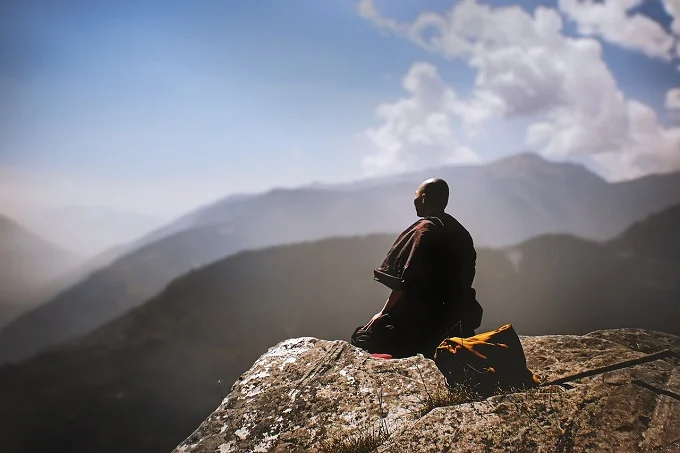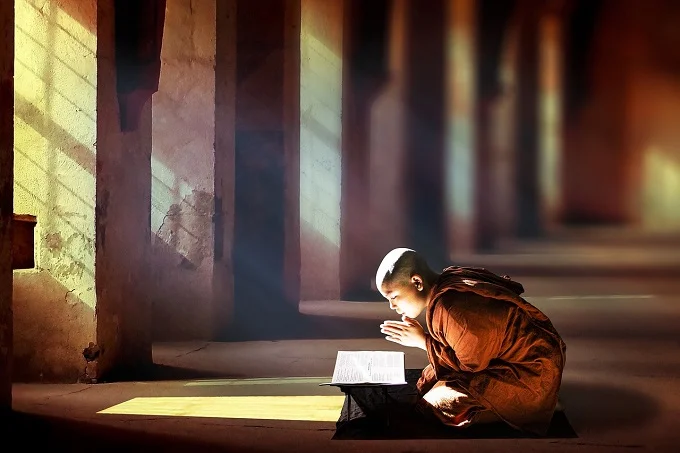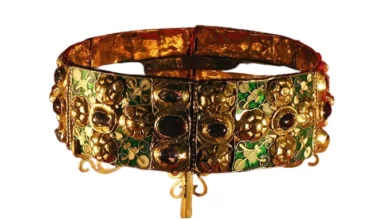Monks of the Middle Ages and God’s people in black robes

The practice of monasticism has been around for many years and is an important aspect of history from the ancient world. In point of fact, many of the historical texts discovered by archaeologists were written by monks who lived in ancient times. Since its inception, monasticism has seen various changes in the course of its existence. Generally speaking, the monastics’ spiritual views are determined by the particular faith to which they belong.
Have you ever given any thought to what it may have been like for some people to live throughout the middle ages as monks? You’ve probably given some thought to the question of why people choose to live the life of a monk and what they do daily.
In the following sections, we will discuss the evolution of monasticism throughout time, as well as the history of monasteries, typical monk beliefs and habits, and the creation of monastic communities.
The conversion of recluses into Monks
The origins of monastic communities have been documented as far back as the sixth century BC. Records show that ancient Hinduism placed great emphasis on hermitage and seclusion, even if the practice was not yet known as monasticism at the time. Ashramas were the communities where these hermits, who had dedicated their lives to a life of poverty in order to become more holy, would dwell in. On the other hand, despite the fact that there are a few key distinctions between the two, it is generally accepted that the holy communities that came before monasticism were the forerunners of the practice.
The transition toward monasticism didn’t take place in India until many decades later. The roots of Jainism may be traced back to Hinduism. Jainism is an ancient Indian religious system that emphasizes living a life that is free from harm and is dedicated to renunciation. Historians are of the opinion that early Jainists formed the first formal notion of monasticism by taking the idea of these holy men from ancient Hinduists and applying it to their religion. In Jainism, two distinct groups were established: monks and nuns. Both were subject to stringent rules and given the heavy responsibility of bringing their karma levels down.
The Buddhist monks, who are now one of the world’s most well-known groups of monks, descended from the Hinduist monks who arrived before them. Instead of completely isolating themselves from their communities, Buddhist monks devote their lives to serving others, both locally and globally, via activities such as teaching, preaching, and providing food. As a consequence of this, some contemporary communities of Buddhist monks around Asia have amassed significant riches, which has been the subject of severe criticism, despite the fact that this is not something that is particularly unusual for monasteries.
The Essenes started their religious community about the second century BC. The Essenes are recognized today as the first type of monasticism to exist in the Middle East. They are a branch of Judaism. The Essenes adhered to beliefs and practices that were consistent with those of monasticism. These included practicing frequent prayer, manual work, meditation, and studying sacred books (in this case, the Torah). The Essenes, who were dissatisfied with being ruled by the Romans, quickly came up with the concept that the Messiah would come at some point in the future to save them from a government that was so corrupt. During this time period, they are credited with writing the holy books known as the Dead Sea Scrolls. These scrolls provided historians with a deeper understanding of early Judaism and Christianity.
Only a few decades later, the first traditional Christian monks appeared in the third century after Christ. It is thought that during this period, certain Christians decided to shift their lives away from worldly items and fled to the desert to adopt a life of minimalism. The purpose of this getaway was to get away from the distractions of the outside world so that they might have a clearer spiritual vision and become closer to God. A significant number of these new Christian hermits escaped to Egypt and Syria in order to spend the remainder of their lives in seclusion from the general population.
On the other hand, some Christians were forced to abandon their faith. Some Christians were compelled to flee the region because of the local persecution, and they ultimately found other Christians who were also being persecuted there. After that, these Christians came together to build a new way of life that was apart from the rest of society.
These early iterations of monasteries were crucial in shaping early monastic ideals about the significance of community and the need to depend on one another to make it through a corrupt and hostile world.
The initially established monasteries
The origin of the first formal monastery during this period may be traced back to Western Europe. At this time, monastic ideals were accepted by Celtic Christians in Gaul. Saint Martin, the third Bishop of Tours, was the one responsible for the construction of the monastery at Ligugé. The concept of monasticism eventually made its way all throughout Europe from this location.
In the fifth century, the Byzantine Empire and Roman Europe became aware of monasteries located in different parts of the world after the common era. As a direct consequence of this, the people who practiced religion in those regions started developing their very own monastic customs based on the teachings of Saint Benedict of Nursia. Saint Benedict is venerated as a Christian saint by a number of Christian denominations, including Catholicism, Oriental Orthodoxy, and Anglicanism, among others. As a result of his unwavering commitment to the activity throughout his life, he is recognized as the “founder of Western monasticism.” He lived during the 5th and 6th centuries AD. The Benedictine monks were, without a doubt, the ones who followed in his footsteps.
During these centuries, the practice of monasticism emphasized living a life that was uncomplicated and contained only the essentials. This consisted of having basic foods, accommodations and having few or no personal belongings at all. As a result of the establishment of formal regulations, the men who lived the monastic life became known as “brothers” because they lived together and adhered to the same guidelines.
In spite of the fact that all monasteries, on the whole, adhered to the same principles regarding the importance of leading a simple life, the manner in which they carried these principles out varied. In some monasteries, the rules were much more stringent than in others, and residents were not permitted to own personal belongings or engage in activities that brought them personal pleasure. However, in other monasteries, residents were permitted to keep a limited number of such items for practical reasons (i.e., grooming, sleeping, etc.).
Although monasteries were primarily communities of guys dedicated to a life of simplicity and godliness, it was possible for women to join these communities as well. It was more common to refer to them as nuns rather than monks, and they would reside in nunneries as opposed to monasteries. In other instances, monasteries and nunneries were both governed by the same abbey. Although they had distinct living quarters, they shared territory as well as the authority of the establishment.
A typical day in the life of a Monk during the Middle Ages
Monks in the middle ages devoted their whole lives to religion. Worship, reading, writing, and physical work were the primary activities that made up each day of their lives, regardless of the particular faith they followed. Because the vast majority of monks in Europe practiced some flavor of Christianity, particularly throughout the middle ages, they would routinely read from their Bibles, pray in secret, and contemplate at various points during the day.
The monks would do manual labor inside their monasteries whenever they were not engaged in the practices of reading sacred texts or praying. Cleaning, cooking, planting, harvesting in gardens, making hay, teaching young boys, writing, and giving medical care to the community were just some of the tasks that monks were responsible for in order to maintain the monastery’s high standards. They were under the impression that in order to appease God, they had to devote whatever spare time they had to improve their house, the neighborhood, and the training of future monks.

For example, the fundamental motto that Benedictine monks lived by was “Ora et Labora,” which translates to “Pray and Work.” In this manner, did they go about their daily lives, and they adhered to a routine that included predetermined times for prayer as well as work.
In addition, medieval monks delegated responsibilities to one another. In a single monastery, there may be monks with several titles or activities, such as abbot (the leader of an abbey), cantor (the leader of the choir), lector (the author and reader of church teachings), and sacrist (the person in charge of the holy relics) (safe keeper of books, vessels, and overall monastery). Although there were a number of other jobs, each monk in a monastery was accountable for at least one of the positions for which they were responsible. In less significant monasteries, it is not uncommon for a single monk to simultaneously serve in many capacities, including abbot and lector.
In the days of the Middle Ages, monks also had certain hours of the day that they devoted to various forms of recreation. Routines are often developed in monasteries to ensure that tasks are always met, whether it is taking care of the monastery itself or ensuring that the monks have sufficient time each day to devote to prayer and meditation. In point of fact, monks were known to adhere to a text known as the Book of Hours.
The Book of Hours is a Christian devotional book that includes a number of prayers to be said at various times throughout the day. Since these volumes were used so often, they are now the medieval documents that may be discovered the most frequently all throughout Europe.
The Book of Hours contains instructions for a number of various forms of worship that a monk has to do in order to remain spiritually connected to God. These eight distinct “hours” comprise Matins at 2:00 am, Lauds at 5:00 am, Prime at 6:00 am, Terce at 9:00 am, Sext at 12:00 pm, Nones at 3:00 pm, Vespers before 6:00 pm, and Compline after 6:00 pm. During these periods of prayer, the monks put their manual labor on hold so that they might participate in devotion. It was disobedience to God to miss these hours. Typically, monks would retire to their quarters just after 6 o’clock in the evening and then rise up at 2 o’clock in the morning for Matins.
Religious rules of Medieval Monks
A vow of celibacy was one of the general rules that monks were required to follow. Other general norms included living a simple life with few or no personal goods. As a consequence of this, monks and nuns were not permitted to get into any kind of sexual connection, nor were they permitted to be married. Engaging in these connections would be equivalent to drawing one’s attention away from God, which would completely defeat the purpose of monasticism.
It was common practice to forbid monks from speaking as well. At least in some areas of the monastery, taking a vow of silence was a method to demonstrate one’s dedication to the religious practice. The fact that the monastery maintained its quiet on a regular basis further demonstrated its spiritual (and even bodily) isolation from the rest of the world. If there was going to be any talking at all, it had to take place in certain locations and only for functional reasons, rather than in everyday interactions.
Both monks and non-monks were differentiated from one another by the method in which they showed themselves physically. They would shave the tops of their heads, but they would leave a ring of hair just above the ears, and they would cover their whole bodies with clothing. The majority of the time, you may find them dressed in robes, cloaks, tunics, linen underclothes, and socks. In order to hold these baggy clothing tight to their bodies, the wearers would wrap a leather belt or a rope around their waist and secure it with a knot.
If a monk was indeed permitted to have any personal things at all, they were very limited in scope. A monk’s standard equipment would often consist of a pen, knife, comb, handkerchief, and sometimes even a sewing kit. To keep them warm, their beds were topped with straw, and they were received a blanket made of hand-woven wool.
In many cases, monks were forbidden from leaving the premises of the monastery. There were very few exceptions to this rule, and the abbot had to give his blessing for each one. The only exceptions to this rule are when there is a chance to give a sermon to the general public on monasticism, participate in community service, or travel to other monasteries for a special reason. Helping the needy, constructing hospitals, orphanages, public bathhouses, and public housing, as well as teaching young people using their libraries and literature, were all ways in which their society may benefit from their involvement. In addition to these things, monks spent each and every day of their lives in the monastery, where they worked nonstop and never ventured outside.
Even though individual monks were relatively impoverished and had very few personal things, monasticism eventually developed into a wealthy institution during the course of the Middle Ages. The lives of monks were governed by a stringent cycle of prayer and labor, but they received no monetary compensation for their efforts, at least not on an individual level. However, the monasteries became prosperous, mostly due to what constituted a supply of free labor.
The monks were responsible for tending the fields and livestock, as well as producing beer, cheese, and other goods for sale. As a result of all of this, money was produced, which could then be used to invest in the construction of bigger monasteries and the purchase of more land. Whether by accident or by purpose, the monastic industry evolved into a thriving commercial sector.
They put forth a lot of effort to better their society, and as a result, they were often recognized for their contributions and, in later years, they were given monetary incentives in recognition of their efforts. The monks were often compensated with food, which enabled them to continue their life without outside support. The monks were given animals for their flesh and plants for their ability to produce fruits and vegetables, which supplied them with an abundance of food to last them throughout the full year. Even though monks had very little resources, they were never concerned about running out of food.
How the Order of Monks first began
You may be wondering: what precisely is the purpose of becoming a monk in the first place? Even if the concept of having little material belongings could be enough to put some people off, the thought of being closer to God was often enough to sway medieval monks. The fact that they were able to help the less fortunate and those who were ill or injured brought a sense of fulfillment to many of them as a result of the work they did in the community. Additionally, as was discussed before, being a monk increased one’s odds of never having to worry about becoming hungry. Throughout the community, monks were normally regarded in very high esteem, and members of the community revered them.
In addition to this, the majority of monks began their training at an early age in order to become monks. Young boys who hailed from low-income homes were often sent to monasteries in order to provide them with an opportunity for an education and a future job.
Although kids as young as five were welcome, the majority of monks didn’t take in new recruits until they were in their pre-teens. Oblates were those less than 15 years old, while novices were those older than 15 years old but had not yet become monks.
These young individuals were guided through the monastic life by monks who also taught them its tenets and practices. You may take your vows and become a complete monk after a year of being a novice; but, according to new laws that were formed in the 1200s, you had the option to quit the order at any time. As a direct consequence of this, monasteries almost never had a shortage of fresh monks.

Modern Monks
Monasticism is still practiced today, despite its popularity being nothing like what it was in the middle ages. There are around 200 different communities of Anglican monks spread over the globe at the present time. The number of people choosing to live as monks has increased significantly, particularly in the countries of Vanuatu and Papua New Guinea. Monks in the modern day are focused on the future and make it their mission to utilize their good deeds to both improve the world around them and draw people closer to God.
It’s possible that now that you have more information on monasticism, the concept of it has piqued your interest. On the other hand, the thought of sleeping on anything other than your memory foam mattress topper may cause you to recoil in horror.
In any case, monasticism is an intriguing way of life that attracts a growing number of followers each year. If you are interested in monasticism in your region and want to learn more about it, you should contact the church or monastery in your area so that you can find out how they may be influencing the people who live there.




